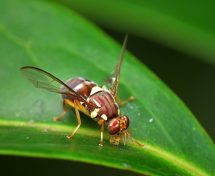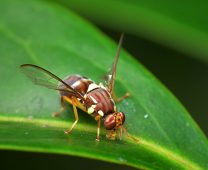A study published this week in Scientific Reports by researchers from Macquarie University Applied BioSciences reveals that Queensland Fruit Fly (Q-fly) can detect the presence of potential predators by smell. Incredibly, the study also found that Q-fly modify their behaviour based upon this detection, adopting predator-specific responses.

Queensland fruit fly. Image by Wikipedia Commons
In the study Q-flies were exposed to odours from four different predators (three spiders and an ant) and one non-predatory insect, by blowing charcoal filtered air over the insects. The researchers then observed the flies' behaviour in four key areas - movement (motility), seeking food (foraging), egg laying (oviposition) and mating. Each of these behaviours is essential for insect fitness.

Queensland fruit fly. Image by Wikipedia Commons
PhD candidate and lead author Vivek Kempraj says the flies showed a significant reduction in foraging, mating and egg laying activity in the presence of predatory insect scent cues. "Each of these activities is essential for insect survival and so the impact of the olfactory cues is noteworthy".
The predatory insects also significantly influenced the movement of the Q-flies as well, with both increased and decreased movement rates, depending on species. Kempraj suggests that "this may be due to the differences in the predation techniques used with a reduction in speed being advantageous to evade nocturnal predators whilst the opposite holds true for daytime predators".
Kempraj also notes that "the flies used in our experiments had never previously been exposed to predators, which suggests that the behaviour responses must be innate rather than learned".
He says his work was an important part in developing our knowledge about predator-prey interactions in Q-fly other fruit flies and insects more generally. "The findings have the potential to influence our management of Q-fly as a pest insect. With multiple hosts across a range of commercially important crops, Q-fly is a significant threat to Australia's horticulture industry, costing up to $300 million dollars in lost market opportunities each year, and advances in this area would be welcomed by industry".
Head of Applied BioSciences Distinguished Professor Phil Taylor agrees, saying "The idea that fruit flies can smell and respond to their enemies, without ever coming into contact, is highly novel. This has not been found in any species previously and is a major step forward in our understanding of the relations between fruit flies and their enemies".
This research is part of the SITPlus collaboration project Raising Q-fly Sterile Insect Technique to World Standard (HG14033), funded by the Hort Frontiers Fruit Fly Fund, part of the Hort Frontiers strategic partnership initiative developed by Hort Innovation, with co-investment from Macquarie University and contributions from the Australian Government. Mr Kempraj was additionally supported by funds from the Australian Research Council Industrial Transformation Training Centre for Fruit Fly Biosecurity Innovation.






